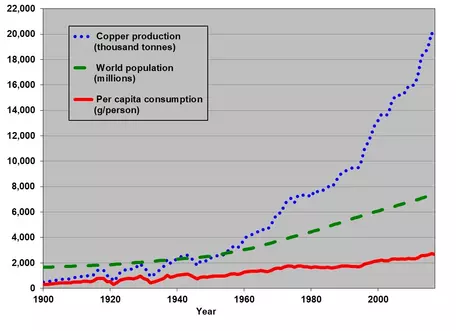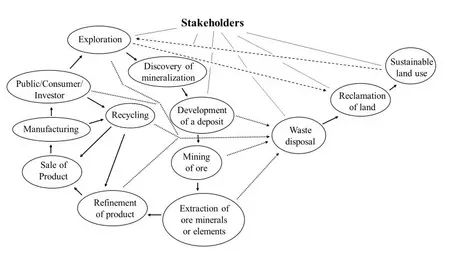The Varied Roles of Geoscientists in Mining
Jonathan G. Price, State Geologist Emeritus, Nevada Bureau of Mines and Geology, University of Nevada, Reno
Introduction
Geologists play many essential roles in the life cycle of mining. These include technical aspects of discovery and development of ore deposits, safely and efficiently mining ore and extracting valuable minerals, and environmental protection and sustainable land use after mining. Geologists, particularly ones with good social and business skills, often also play key roles in interacting with stakeholders to obtain social and regulatory licenses to operate and with investors to raise capital to explore and mine.
Different types of geologists are needed for mining to be as sustainable as possible, with rewarding job opportunities in industry, government, and academia. Geologist is broadly defined as a scientist who studies the Earth and Earth processes. Geologist therefore includes specialists in various subdisciplines and related aspects of science and engineering: geochemist, geophysicist, structural geologist, engineering geologist, environmental geologist/scientist, geobiologist/ecologist, geoarchaeologist, paleontologist, stratigrapher, petrologist, mineralogist, geometallurgist, geomorphologist, geographic-information-specialist/geographer, geostatistician, hydrogeologist/hydrologist, engineering geologist, geological engineer, geotechnician, geotechnical engineer, etc., any of which is commonly termed a geo in the mining industry. An economic geologist (including exploration geologist and mine geologist) has come to mean a geologist who specializes in mineral resources, but the skills of a good economic geologist may include those of many of the specialists listed above. The mining industry employs not just traditional economic geologists but all these geo specialists.
The Need for Mineral Resources
Mineral resources are essential for society to function. For example, copper is used primarily for the transmission of electricity in homes, businesses, automobiles (more so in electric than gasoline-powered ones), and many other machines. Although gold and silver are better conductors than copper, copper is more abundant and much less expensive. [Gold is used in cell phones and computers, and silver is used on solar panels.] Annual global production of copper is near an all-time high (Fig. 1) and will likely continue to increase with increasing population and standards of living. A laudable goal is to recycle as much of a mineral resource as possible, but as long as more copper is needed each year, recycling will not be able to keep up with demand, and more mining will be needed. Recycling of copper accounts for approximately 31% of supply in the U.S. (Brininstool, 2018).
Geoscience Communication Skills
Stakeholders are involved throughout the life cycle of mining (Fig. 2). These individuals and groups include residents and businesses of local communities and regional jurisdictions; indigenous people from the area; governmental regulators; investors, corporate leaders, and employees; suppliers; academicians; and non-governmental organizations and other concerned individuals. Because exploration geologists are commonly the first people on the ground representing mining companies, their social and communication skills are vital to setting the stage for transparent and trustful interactions with stakeholders as an exploration project advances through discovery of mineralization, development of an ore deposit, mining, extraction of ore minerals, waste management, land reclamation and related environmental protection to long-term, sustainable land use.
Communication and social skills are key for geologists to explain their views to management and regulators. For example:
- with information from geological mapping and geophysical and geochemical surveys, geologists recommend where and how deep to explore;
- with geochemical data collected during exploration, geologists caution about environmental concerns due to potentially toxic elements in the ore and waste rock;
- with mineralogical and structural data from exploration drilling, geologists identify safety hazards for mining engineers to mitigate;
- with petrographic observations of ore minerals and their intergrowths, geologists advise metallurgists about options for mineral extraction;
- with expertise in erosion control, slope stability, and hydrology, geologists help plan for waste disposal, reclamation, and sustainable land use.
Geoscience courses that reward excellent written and oral reports and encourage discussion of technical, economic, social, environmental, and ethical issues help students develop their communication skills.
The Life Cycle of Mining
The mining life cycle (Fig. 2) isn't as cyclical as, say, the hydrologic cycle. A mine or exploration site may follow the paths on the right-hand side of this figure. Exploration is often unsuccessful in discovering a mineral deposit, and many deposits cannot be profitably mined; any waste generated during exploration and development must be disposed, and these sites need to be reclaimed, with the land returned to a long-term beneficial use. If ore is mined, the product may be a mineral (e.g., barite, BaSO4, which is used in the drilling and medical industries as a dense, insoluble material) or a chemical element that is used in consumer products. In either case, refinement is normally needed before selling a nearly pure product either directly to consumers (e.g., gold bars for investment) or to a manufacturing plant, where a final product (e.g., a car or cell phone) is made. Consumer demand ultimately dictates the price of the mineral resource, thereby influencing exploration and completing the left-hand side of the life-cycle figure. Sustainable land use can take many forms, including returning the land mostly to its pre-mining state or creating a post-mining industrial site (for, say, solar or wind power generation). Because ore deposits often occur in clusters and with less economic mineral deposits on fringes, another post-mining use may be more exploration.
A series of articles in the Newsletter of the Society of Economic Geologists (Wood, 2018; Wood and Hedenquist, 2019) provides more details about roles of geologists in mining. Rewarding jobs related to mining can be found in industry (exploration, development, mining, and reclamation), government (regulatory oversight and providing data and maps that stimulate exploration and aid in long-term sustainable land use), and academia (teaching the next generation of geologists and conducting research that generates new ideas and approaches to exploration, ore processing, waste management, and reclamation). Preparing students for these jobs involves exposure to a wide variety of geoscience topics as well as development of the communications skills that will be needed to succeed.
REFERENCES
Brininstool, Mark, 2017, Copper, in Mineral Commodity Summaries 2017, U.S. Geological Survey, p. 54-55.
Price, J.G., 2013, The challenges of mineral resources for society, in Bickford, M.E., ed., The impact of the geological sciences on society: Geological Society of America Special Paper 501, p. 1-19.
Price, J.G., and Espi, J.A., 2014, Disponibilidad y retos actuales de los recursos minerales para la sociedad: Boletín Geológico y Minero, v. 125, no. 1, p. 3-29, ISSN: 0366-0176.
Wood, Dan, 2018, Geology and mining: an introduction and overview: Society of Economic Geologists Newsletter, No. 115, p. 1-21.
Wood, Dan, and Hedenquist, Jeffrey, 2019, Mineral exploration: discovering ore deposits: Society of Economic Geologists Newsletter, No. 116, p. 1-21.


![[reuse info]](/images/information_16.png)
